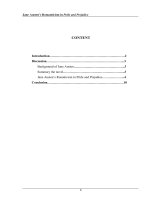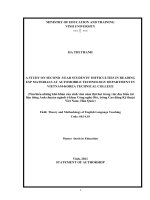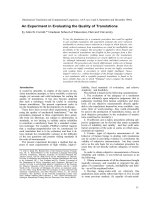TEST-BED URBANISM: SONGDO''S EXPERIMENT IN DIGITAL INFRASTRUCTURE AND EPISTEMOLOGY
Bạn đang xem bản rút gọn của tài liệu. Xem và tải ngay bản đầy đủ của tài liệu tại đây (732.12 KB, 35 trang )
<span class="text_page_counter">Trang 1</span><div class="page_container" data-page="1">
<b><small>Figure 1 Songdo International Business District under construction, Incheon Free Economic Zone, </small></b>
<small>South Korea, July 6, 2012. (Image: Jesse LeCavalier)</small>
</div><span class="text_page_counter">Trang 2</span><div class="page_container" data-page="2"><b>Test- Bed Urbanism</b>
<i>Orit Halpern, Jesse LeCavalier, Nerea Calvillo, and Wolfgang Pietsch</i>
<i><small>We also have houses of deceits of the senses, where we represent all manner of feats of juggling, false apparitions, impostures and illusions, and their fallacies. And surely you will easily believe that we, that have so many things truly natural which induce admiration, could in a world of particulars deceive the senses if we would disguise those things, and labor to make them more miraculous.</small></i>
<i><small>Sir Francis Bacon, New Atlantis</small></i>
<i><small>The implementation of the U- City (Ubiquitous City) system based on IT technology . . . allows you to take part in daily want. Your life will be more comfortable with technology you never experienced before.</small></i>
<i><small>Incheon Free Economic Zone, We Build Success brochure</small></i>
<b>T</b>
here is a new New Atlantis rising from the sea. This is a city that, like the seventeenth- century utopia of Bacon’s imagination, is purported to support the future of science, art, and commerce. The forms of experiment and rationality that govern this territory are, however, distant from the enlightened reason and empirical experimentation of Bacon’s envisioned ideal society. This territory will be governed not by a concentrated group of advanced leaders but by a diffuse network of machines.The city is called Songdo. It is one hour’s drive southwest from Seoul and is
<i><small>Public Culture 25:2 </small></i> <small>DOI 10.1215/08992363- 2020602 </small>
<small>D I G I TA L I N FR A S T RU C T U R ES : ESS AY</small>
</div><span class="text_page_counter">Trang 3</span><div class="page_container" data-page="3"><b><small>Public Culture</small></b> <sub>being built from scratch on land claimed from the ocean. Songdo is one of a trio </sub>
of cities that make up the Incheon Free Economic Zone (IFEZ), a development initiated by the Korean government to attract foreign investment and residents. Songdo’s distinguishing feature is the promise of its ubiquitous physical comput-ing infrastructure. Marketed as a “smart city,” it is presented as an entire territory resources of another era, be mined for wealth and, similarly, will generate sub-sequent infrastructure for new forms of life. The city is envisioned as a physical incarnation of an immense cloud of big data; its purpose and value are generated by speculation on how sensitive its infrastructure of sensors and cellular commu-nication towers is, on how much data the city can generate, and on how capable its high- bandwidth conduits are to circulate these data. IFEZ is like a holding -ined as mobile, plastic territories. They are simultaneously software, hardware, screen, algorithms, and data (Crang and Graham 2007), serving as interfaces and conduits into networks linked to other territories. These cities, like computational infrastructure of information and economy. As a leading example, Songdo offers a unique vantage point from which to examine this global cultural and economic logic of large data sets.<small>1</small>
experimentation, Songdo is also touted as an ideal site for new forms of experi-mental practice. For example, Songdo has been referred to as “the experiexperi-mental
-understood as a model that can be bought, replicated, and deployed (Choi, pers. comm.). However, unlike the older forms of Enlightenment science, this experi-a new form of epistemology thexperi-at is concerned not with documenting fexperi-acts in the world, mapping spaces, or making representative models but rather with creating
<small>1. Much of this information was gathered from site visits to Songdo and Seoul on July 1 –8, 2012. We visited Digital Media City Showroom on July 2, 2012 , and spoke to Professor Dr. Donyun Kim of Sung Kyun Kwan University at Samoo Architects and Engineers on July 3, 2012. We interviewed </small>
<small>Kim of the U- City Business Division of IFEZ and Kyung- Sik Chae of the Culture and Arts Divi-sion from Incheon Metropolitan. On July 6, we met Tony Kim, director, Internet Business Solutions Group (IBSG), Cisco Systems Korea, and Gui- Nam Choi, a services sales executive of Cisco Sys-tems Korea. We are very grateful for their help and generosity.</small>
</div><span class="text_page_counter">Trang 4</span><div class="page_container" data-page="4"><b><small>Test-Bed Urbanism</small></b>
<i>models that are territories. Performative, inductive, and statistical, the </i>
experi-ments enacted in this space transform territory, population, truth, and risk with implications for representative government, subjectivity, and urban form. These features of what we are calling “test- bed urbanism” are increasingly evident glob-ally, both in new “smart city” projects (Hollands 2008; Ho Lee et al. 2008) and
-that this test- bed urbanism is a form of administration and a redistricting of
bod-operations “on the ground” at Songdo in order to assemble initial evidence in support of our concluding speculative claims concerning the epistemology of the test- bed city.
Finally, Songdo, unlike other ideal cities whether built or unbuilt, has no per-fect whole and thus is both literally and conceptually incomplete. However, it re-mains utopian in the sense that it aspires to achieve new forms of life, even in a perpetually provisional version (Gordin, Tilley, and Prakash 2010). This city is a rehearsal of our future and an archive of our past. The purpose of this essay is to excavate this wishful thinking and to examine the tense relationship between performance and aspiration. Like all utopias, Songdo is also a “heterotopia,” a space that can tell us about our world, make us conscious about the choices — aesthetic, architectural, designed,
and technical — that we are making and still have to make. Most importantly, these mir-ror worlds — dystopian, ugly, banal, beautiful — provide us with visions of alternative real-ities and portents of events we might seek to avoid (Foucault realize that what we assume to be natural — the desire, for ex-ample, for a “smart” planet — is contested, situated, and histori-known, and the future is not al-ready here.
<b><small>Figure 2 Utopian urban forms have changed from ideal to performance- based </small></b>
<i><small>geometries. Left: frontispiece for Sir Thomas More’s Utopia (1518) by Ambrosius </small></i>
<small>Holbein; upper middle: Sforzinda by Filarete (15th– 16th century); lower middle: Coevorden (the Netherlands, early 17thcentury); upper right: Jurong Island, Singapore; lower right: Songdo.</small>
</div><span class="text_page_counter">Trang 5</span><div class="page_container" data-page="5"><b><small>Public Culture</small>Arriving on New Shores</b>
<i>The phrase smart city can be feasibly applied to a large number of diverse </i>
inter-national projects that range from the updating of telecommunications
<b>infrastruc-ture to the construction of entirely new, planned cities. Robert </b>
by 2010. The common denominator in most of these projects is an investment in digital infrastructure and a belief in the possibility of “improving life through from the development of a 225,000- person “smart valley,” as in Portugal’s Living PlanIT project, to 2.5 million people projected to eventually settle in Songdo, one of the largest smart city projects to date. Gale International, a Boston- based real estate company, is developing Songdo with the support of the Incheon municipal government. The new city is part of the larger IFEZ, a new juridical designation
<b><small>Figure 3 Promotional material from IFEZ uses an aerial perspective to show the extents of the </small></b>
<small>development. In the upper right, the Incheon Bridge and international airport beyond are visible. </small>
<i><small>(Image: Incheon Free Economic Zone, We Build Success brochure, 3)</small></i>
</div><span class="text_page_counter">Trang 6</span><div class="page_container" data-page="6"><b><small>Test-Bed Urbanism</small></b>
that also includes Cheongna and Yeongjong. Songdo is connected to the Korean mainland by electronically monitored bridges and is strategically located close to Incheon International Airport. IFEZ actively courts foreign investment and -ties, and the promise to be one of the world’s “smartest” urban regions (J. Kim, pers. comm.). In pursuit of this goal at Songdo, Gale enlisted the San Jose – based networking company Cisco to develop many of the smart technologies and ser-vices and the attendant infrastructure (Lindsay 2010; Cortese 2007).
Famous for building routers and infrastructure for networks, Cisco now aspires to become a management consulting corporation, with the expertise to build the informational infrastructure for cities of millions of people overnight. Its main concern is increasing the demand, therefore, for bandwidth. It hopes to produce, what its competitor IBM has labeled, a “smart” planet.<small>2</small> Cisco Systems was and eventual effective monopoly on networking devices and management. How-ever, in 2006 the company changed its name to simply “Cisco” and began focusing
to be a plumber . . . but now we’ve moved from plumbing to being a platform for innovation” in order to suggest to governments or other actors how they might
initiative using the network as the platform to transform physical communities to connected communities run on networked information to enable economic, social project and is developing different aspects of it in numerous countries and with a range of international partners. The network- hardware- provider- turned- urban- development- consultant has projects in major cities in countries that include South
<small>2. IBM (2012) has an entire new management consulting service branded around “smart planet” rather than mainly selling hardware like routers for digital infrastructure. In building these cities, conduits, routing systems, sensors, telecom towers, and other hard portions of the infrastructure are built by telecom companies with which Cisco collaborates. In this case Cisco partnered with Korean Telecom (KT), and the buildings are built by Gale International, a Boston- based developer, with Shanghai, Hong Kong, Seoul, Abu Dhabi, and London. (T. Kim and Choi, pers. comm.). </small>
</div><span class="text_page_counter">Trang 7</span><div class="page_container" data-page="7"><b><small>Public Culture</small></b>
Korea, the United States, Spain, England, the Philippines, the Netherlands, China, Mexico, Canada, India, Portugal, Russia, Vietnam, Kuwait, Malaysia, and Saudi Arabia and continues to expand as we write. Cisco’s list of partners is almost as long as the number of countries in which it is active. However, since most are highly specialized digital infrastructure providers, none of them are especially well known. Gale, in partnership with Cisco and the Korean construction com-pany Posco E&C, is trying to change that.
At the center of Songdo’s marketing materials and technical discourse lies a fantasized transformation in the management of life — human and machine — in terms of increased access to information and decreased consumption of resources. ambitious instant city since Brasília 50 years ago. . . . It has been hailed since conception as the experimental prototype city of tomorrow. A green city, it was
<b><small>Figure 4 In order for Songdo to deliver the services promised, it requires a network with sizable </small></b>
<small>data rate capacity, that is, bandwidth. This increased demand for the provision of network </small>
<i><small>infrastructure is one of the attractions for Cisco. (Image: Incheon Free Economic Zone, We Build </small></i>
<i><small>Success brochure, 5)</small></i>
</div><span class="text_page_counter">Trang 8</span><div class="page_container" data-page="8"><b><small>Test-Bed Urbanism</small></b>
of a typical metropolis its size. . . . And it’s supposed to be a ‘smart city,’ studded with chips talking to one another.” The article goes on to address the role of Cisco in the project and its plans to “wire every square inch of the city with synapses” argue for a speculative space ahead of its time that operates at the synaptic level of its inhabitants. So, for example, there is a great predilection for implanting LED screens everywhere and pushing video conferencing to be integrated with other bio- and labor- monitoring devices. Video demands high bandwidth above and beyond all other media formats. Cisco’s strategic planners envision a totalizing sensory environment in which human actions and reactions, from eye movements
<b><small>Figure 5 “Life in the Incheon Free Economic Zone is peaceful and abundant with parks and broad </small></b>
<small>fields of green covering more than 30% of the city. There is a new city waste incinerating facility, a treated sewage recycling system and other systems, which work beyond eyeshot.” Sustainability is the narrative twin to “bandwidth” in Songdo’s promotional material. The reduction of resource consumption through an increase in data consumption provides justification for future investment </small>
<i><small>in research and growth. (Image: Incheon Free Economic Zone, We Build Success brochure, 4)</small></i>
</div><span class="text_page_counter">Trang 9</span><div class="page_container" data-page="9"><b><small>Public Culture</small></b>
to body movements, can be traced, tracked, and responded to in the name of
<small>con-3</small> Every wall, room, and space is a potential conduit to a meeting, a separate building, a remote lab, or a distant hospital. The currency of human attention at its very nervous, or even molecular, level.
This manipulation of synapses — both those of the city and those of its inhabit-ants — is closely linked to a second discussion about the resulting outgrowth of sustainability as a guiding principle. Consequently, the two discourses that shape the speculation around Songdo and offer insight into the infrastructural logic of
<small>these terms, but they were useful as a goal and an ideal. It is also worth noting that whatever these terms may denote, they are always extendable, as, incidentally, are the concepts of “intelligence” and “smartness.”</small>
<small>telemedicine applications. Some engineers even spoke of transforming the laws of South Korea to in the home to medical sites in the proliferation of home health- care services (J. Kim, pers. comm.; T. Kim, pers. comm.).</small>
<b><small>Figure 6 The PPCC creates new sources of revenue by creating tiers of digital services for both </small></b>
<small>individuals and for governments. (Image: Cisco 2012b: 13)</small>
</div><span class="text_page_counter">Trang 10</span><div class="page_container" data-page="10"><b><small>Test-Bed Urbanism</small></b>
digital media are those of, on the one hand, preparedness for possible ecological
<i>disaster (i.e., sustainability) and, on the other, an expanding capacity for </i>
atten-tive manipulation and management of information, resources, and inhabitants
<i>(i.e., bandwidth). The latter stretches into the very minds of the city’s inhabitants, </i>
who, incidentally, are also increasingly imagined as components in an urban- and environmental data, a fantasy of self- regulating and self- propagating systems emerges. This is a city that may not be fantasized as conscious but certainly fan-tasized as something capable of intelligence and cognition by way of modulating and measuring the affective states and senses of its many inhabitants — human, machine, or otherwise, a notion reinforced even by the adoption of the term “ubiq-Ho Lee et al. 2008).
In spite of its claims of greenness and smartness, Songdo remains challenged -tutional structures as a result. In Songdo, Cisco and IFEZ are experimenting with the construction of a joint venture between public and private companies by which
<b><small>Figure 7 In the case of Songdo, the PPCC comprises IFEZ, individual inventors, and a joint </small></b>
<small>partnership between Korean Telecom and Cisco. (Image: Cisco 2012b: 12)</small>
</div><span class="text_page_counter">Trang 11</span><div class="page_container" data-page="11"><b><small>Public Culture</small></b> <sub>the private sector invests in new data infrastructure with the promise of accessing </sub>
and using public data in return. Cisco has acknowledged that some of the chal-lenges to “service implementation” include “unclear added value of u- services [“ubiquitous” services, which include any service envisioned to be delivered or managed through the high- bandwidth infrastructure such as tele- medicine, energy
these obstacles in the past, the company has turned to what it refers to as “tra-ditional monetization alternatives” including either “subsidies from city govern-ment to pay the services operator [i.e., Cisco] to operate/provide the service to the citizens” or “developers’ subsidies/investments to cover a portion of the expenses considering the potential increase of land valuation resulting from service provi-private cooperation including the formation of a public- provi-private cooperation com-pany (PPCC) that comprises a joint venture between Korean Telecom and Cisco; the IFEZ, which includes the Incheon Metropolitan City, the IFEZ Authority, the Incheon Urban Development Corporation, and other public agencies; and various private developers and strategic partners. The PPCC provides a combination of services, but the main difference is that users pay the PPCC directly for elective services, rather than expect them to be delivered. Cisco hopes that this will make
the services it provides.
In either case, both Cisco and IFEZ are looking for new sources of revenue and hope to “monetize” the attentive capacity of Songdo’s inhabitants. Their hope is to use this latent reserve of data gathered on users to produce services that can be paid for through advertising, electronic education, physical treatment, home telemedicine, or any number of other speculative products vying for a share of this new market. For Cisco — like Facebook, Google, and other companies that attempt to link user behavior at the interface with consumer behavior in order to monetize their vast data sets — data are the currency of this new realm, a realm envisioned as an interface for inserting and extending the sensorium. Songdo is, thus, a parody of the fantastical perpetual motion machine of the without- end through the construction of huge conduits for bandwidth and of vast quantities of environmental sensors, all focused on the monitoring and indexing of its inhabitants’ online and off- line behaviors. These self- referential and self-
</div><span class="text_page_counter">Trang 12</span><div class="page_container" data-page="12"><b><small>Test-Bed Urbanism</small></b>
<b><small>Figure 8 Many “smart poles” are distributed throughout the city to collect and transmit data. </small></b>
<small>Individually, their influence and “intelligence” is limited. However, once networked, their collective information contributes to a certain kind of distributed awareness. (Image: Cisco 2012a: 15)</small>
<b><small>Figure 9 Smart pole detail. </small></b>
<small>(Image: Nerea Calvillo)</small>
</div><span class="text_page_counter">Trang 13</span><div class="page_container" data-page="13"><b><small>Public Culture</small></b> <sub>generating properties make Songdo, perhaps unsurprisingly, mimetic of the logics </sub>
None of the individual elements that constitute this sensing and data- recording system are themselves possessed of any intelligence. They are inert devices designed to absorb input and direct it to a processing center that aggregates it and analyzes it. Sensing devices will be ubiquitous features of the city and will be active in both domestic and public spheres. For the latter, Songdo will use an integrated sensing element called a “smart pole” that provides light, sound, and navigation information. It is also equipped with a closed- circuit television camera receive input either through a call box with an emergency button or through an Internet terminal. These poles will be installed at regular intervals throughout the city and will be capable of both responding to and producing a range of environ-mental conditions. The input collected by any given smart pole is directed to the “integrated operating center” (IOC) that, in turn, analyzes the data and sends back commands to the source.
<b><small>Figure 10 Demonstration control room, Tomorrow City, Songdo. (Image: Jesse LeCavalier)</small></b>
</div><span class="text_page_counter">Trang 14</span><div class="page_container" data-page="14"><b><small>Test-Bed Urbanism</small></b>
A control room is one of the dominant features of an IOC and is an inter-face that conveys to human monitors whatever the digitized urban environment unveils. As such, its power is feeble, its knowledge limited, and its vision blurred. Moreover, though it is prepared to handle emergencies and is clad in the aesthetics of Cold War preparedness, the control room is primarily a site of maintenance. Thus the monitors’ role is one of management and not necessarily one of protec-tion. Monitors survey the changing array of images in search of any perceived disruptions to the system.
In some cases, human monitors bear witness to events unfolding within a cam-era’s cone of vision, but, more often, the large number of recording devices makes keeping track of all these data impossible. Thus the task of extracting relevant information is increasingly handled automatically. The often- used but still
<i>reveal-ing phrase data minreveal-ing reinforces the implicit understandreveal-ing of these practices. </i>
of human and nonhuman inhabitants of the city, turn their recorded activities
<b><small>Figure 11 The control rooms of the IOC would be staffed by monitors charged with watching over </small></b>
<small>an array of screens and interfaces. Much of the management tasks will be automated, but the control rooms still require human oversight. (Image: Cisco 2012a: 18)</small>
</div><span class="text_page_counter">Trang 15</span><div class="page_container" data-page="15"><b><small>Public Culture</small></b>
ethereal ore (Lohr 2012). While these sensors react individually to the informa-they eventually produce becomes a layer of data that covers the city. According to Cisco’s Tony Kim, the Korean government has made over 120 data sets avail-able to private companies in an effort to stimulate economic growth. While this provided a number of opportunities, it also presents challenges in terms of how to archive those data, how to access them, and how to interface with them (T. Kim, pers. comm.).
At the domestic level, it is assumed that every wall, every mirror, and every surface can become an interface that offers users everything from on- demand data and weather reports to home medical monitoring.<small>5</small> But just what do we see
<small>5. The current legal system in Songdo is being lobbied to enact changes in privacy laws that would allow the transfer of medical data outside of the hospital in order for Cisco to roll out its medi-testing kits, blood- work labs, and heart monitoring stations, all to insure the health of the residents of these luxury high- rises.</small>
<b><small>Figure 12 The ubiquity of screens reaches into the domestic sphere as well. While the </small></b>
<small>interfaces remain at the level of object- screens, the aspiration is for less noticeable interfaces. (Image: Cisco 2012a: 10)</small>
</div><span class="text_page_counter">Trang 16</span><div class="page_container" data-page="16"><b><small>Test-Bed Urbanism</small></b>
<small>6. Here it is useful to contemplate what form of data we are discussing. When we talk about data, respect to a person, data are everything that is possible to know about a person, and capta are what is selectively captured through measurement.”</small>
when we look at this universe of doubly communicative surfaces (in that they both send and receive)? In the promotional material from Songdo, these screens are interfaces that help viewers make better decisions to save time, money, energy, or anguish. Through this promise of omniscience and omnipresence viewers/users/ consumers can exceed their human limitations thanks to the automated collection and analysis of data that are suddenly easy to access. But these interfaces work
<i>on us as much as for us. The bilateralism of the interface informs users but also makes them informers. That is, it works to optimize viewers and the network in </i>
which they operate. Because their habits and desires create a map of future habits, supply and demand will eventually merge.
In the meantime, the monetization of human attention continues as companies like Cisco intensify their research into ways to deploy and capture information. The limiting factor in increasing rates of data transmission is the capacity of the hardware and of the network to transmit
informa-tion. Cisco’s turn to urban development and to the production of smart city models and prototypes is an exercise in creating markets for the very hardware on which the company was founded. In fact, it is data, as a conceptual entity, that drive the ambitions of the city.<small>6</small> The dream of data ubiq-still present reinforces the concept of extendable value that emerges through the logic of constantly testing new functions, new products, and new applications. Songdo is driven by a fantasy that by translating everything into data the whole city could be managed as if it were a continuous and apprehensible system.
In this desire to “data- fy” the environment through the extreme expansion of bandwidth, any inhabitant, human or nonhuman, is considered
measurable in different ways and all inhabitants are treated as equal entities in terms of the data they can provide. For example, the movement of people in the
<b><small>Figure 13 Sensor data can occasionally reach conclusions that </small></b>
<small>are self- evident. (Image: Nerea Calvillo)</small>
</div><span class="text_page_counter">Trang 17</span><div class="page_container" data-page="17"><b><small>Public Culture</small></b> <sub>city, the water velocity in a sewer, personal energy consumption, shopping habits, </sub>
browsing patterns, or particulate matter suspended in the atmosphere, to name just a few, all feasibly contribute to the construction of a more responsive urban environment (T. Kim, pers. comm.). Because of the multiple but equally valid sources for these data, it no longer makes sense to address them in terms of quali-about truth to nature or to an external world but is expanded to incorporate the emotional, the affective, and what was previously nonformal knowledge. Even the traces of transactions known as “shadow data,” including phone conversations, credit cards, or movements through the city, are stored and made ready to be recycled for other purposes. However, if until now the choices made about what to collect and why have had histories of controversy and resistance, in the test- bed city the attitude is to collect indiscriminately and to accumulate by default.
The law of probabilities governs Songdo, and thus its mining of past data is done in the name of the future. While those responsible for the development of
<i>Songdo need users before they can manipulate user data, they are nonetheless </i>
proceeding with the implementation of the necessary sensing apparatus, even if its ultimate end use remains unclear. However, even if the precise future of the data cannot be predicted, it will most certainly be analyzed and cross- referenced auto-matically. The promise of such number crunching is that we will learn pre viously unknown things about ourselves based on an idea that the collective behavior of a city can be compiled and analyzed by machines to reveal profound trends in our social behavior. Yet this approach could also easily, and perhaps dangerously, produce a number of false correlations (Spade 2011). A likely outcome of these measure similarities in terms of their deviation from an established norm, pro-of different normal curves producing “an interplay pro-of differential normalities” Instead, “normality” is constantly constituted as it emerges from the summated actions of daily life.
This is not to say that all reference points are removed, only that normative conditions index performance rather than ideal forms. Consider the actual produc-tion of the territory of Songdo as an example. In ideal cities of the past — a lineage in which we can place Songdo — city makers were preoccupied with the pursuit -trast, is conditioned by performance requirements and materializes the count-less and competing protocols to which the city must submit in pursuit of global
</div>








